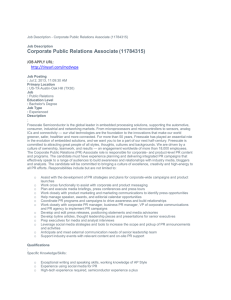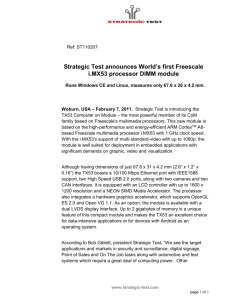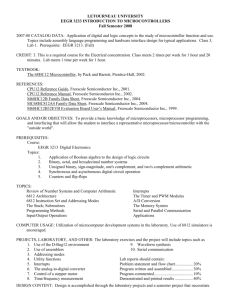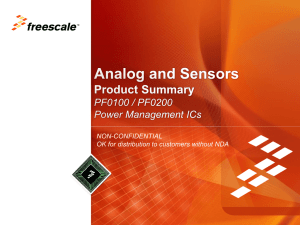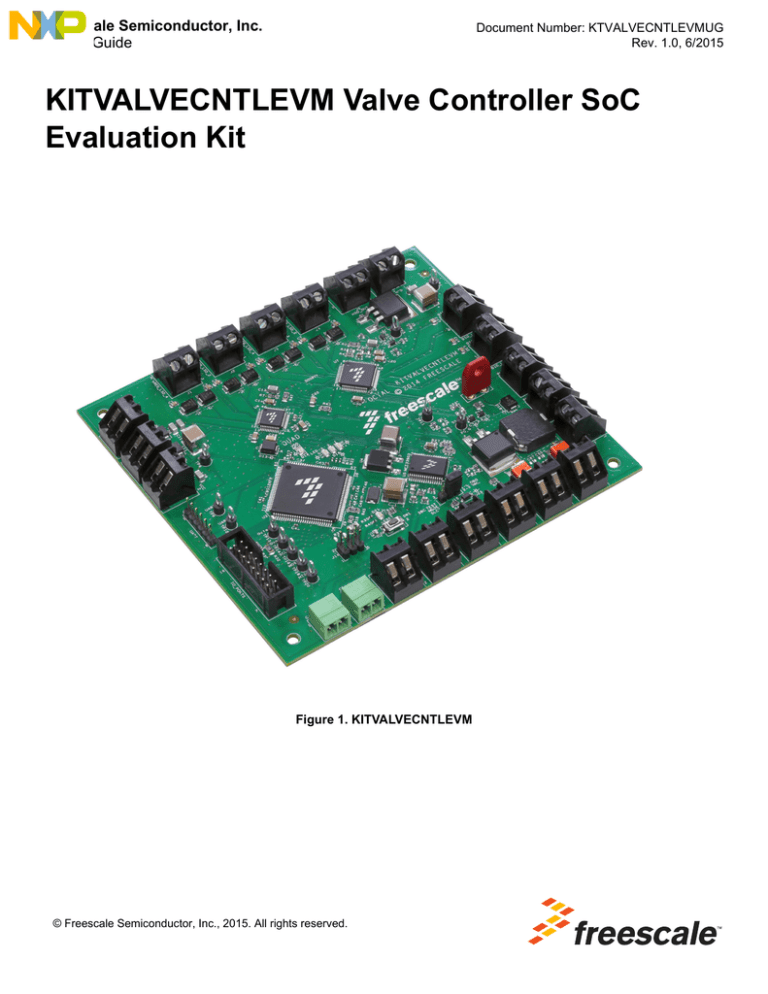
Freescale Semiconductor, Inc.
User’s Guide
Document Number: KTVALVECNTLEVMUG
Rev. 1.0, 6/2015
KITVALVECNTLEVM Valve Controller SoC
Evaluation Kit
Figure 1. KITVALVECNTLEVM
© Freescale Semiconductor, Inc., 2015. All rights reserved.
Contents
1
2
3
4
5
6
7
Important Notice . . . . . . . . . . . . . . . . . . . . . . . . . . . . . . . . . . . . . . . . . . . . . . . . . . . . . . . . . . . . . . . . . . . . . . . . . . . . . . . . . . . . . . . . . . . 3
Getting Started . . . . . . . . . . . . . . . . . . . . . . . . . . . . . . . . . . . . . . . . . . . . . . . . . . . . . . . . . . . . . . . . . . . . . . . . . . . . . . . . . . . . . . . . . . . . 4
Getting to Know the Hardware . . . . . . . . . . . . . . . . . . . . . . . . . . . . . . . . . . . . . . . . . . . . . . . . . . . . . . . . . . . . . . . . . . . . . . . . . . . . . . . . 5
Installing the Software and Setting up the Hardware . . . . . . . . . . . . . . . . . . . . . . . . . . . . . . . . . . . . . . . . . . . . . . . . . . . . . . . . . . . . . . 10
Schematics, Board Layout and Bill of Materials . . . . . . . . . . . . . . . . . . . . . . . . . . . . . . . . . . . . . . . . . . . . . . . . . . . . . . . . . . . . . . . . . . 15
References . . . . . . . . . . . . . . . . . . . . . . . . . . . . . . . . . . . . . . . . . . . . . . . . . . . . . . . . . . . . . . . . . . . . . . . . . . . . . . . . . . . . . . . . . . . . . . 16
Revision History . . . . . . . . . . . . . . . . . . . . . . . . . . . . . . . . . . . . . . . . . . . . . . . . . . . . . . . . . . . . . . . . . . . . . . . . . . . . . . . . . . . . . . . . . . 17
KTVALVECNTLEVMUG Rev. 1.0
2
Freescale Semiconductor, Inc.
Important Notice
1
Important Notice
Freescale provides the enclosed product(s) under the following conditions:
This evaluation kit is intended for use of ENGINEERING DEVELOPMENT OR EVALUATION PURPOSES ONLY.
It is provided as a sample IC pre-soldered to a printed circuit board to make it easier to access inputs, outputs, and
supply terminals. This evaluation board may be used with any development system or other source of I/O signals
by simply connecting it to the host MCU or computer board via off-the-shelf cables. This evaluation board is not a
Reference Design and is not intended to represent a final design recommendation for any particular application.
Final device in an application will be heavily dependent on proper printed circuit board layout and heat sinking
design as well as attention to supply filtering, transient suppression, and I/O signal quality.
The goods provided may not be complete in terms of required design, marketing, and or manufacturing related
protective considerations, including product safety measures typically found in the end product incorporating the
goods. Due to the open construction of the product, it is the user's responsibility to take any and all appropriate
precautions with regard to electrostatic discharge. In order to minimize risks associated with the customers
applications, adequate design and operating safeguards must be provided by the customer to minimize inherent or
procedural hazards. For any safety concerns, contact Freescale sales and technical support services.
Should this evaluation kit not meet the specifications indicated in the kit, it may be returned within 30 days from the
date of delivery and will be replaced by a new kit.
Freescale reserves the right to make changes without further notice to any products herein. Freescale makes no
warranty, representation or guarantee regarding the suitability of its products for any particular purpose, nor does
Freescale assume any liability arising out of the application or use of any product or circuit, and specifically
disclaims any and all liability, including without limitation consequential or incidental damages. “Typical” parameters
can and do vary in different applications and actual performance may vary over time. All operating parameters,
including “Typical”, must be validated for each customer application by customer’s technical experts.
Freescale does not convey any license under its patent rights nor the rights of others. Freescale products are not
designed, intended, or authorized for use as components in systems intended for surgical implant into the body, or
other applications intended to support or sustain life, or for any other application in which the failure of the Freescale
product could create a situation where personal injury or death may occur.
Should the Buyer purchase or use Freescale products for any such unintended or unauthorized application, the
Buyer shall indemnify and hold Freescale and its officers, employees, subsidiaries, affiliates, and distributors
harmless against all claims, costs, damages, and expenses, and reasonable attorney fees arising out of, directly or
indirectly, any claim of personal injury or death associated with such unintended or unauthorized use, even if such
claim alleges Freescale was negligent regarding the design or manufacture of the part.Freescale™ and the
Freescale logo are trademarks of Freescale Semiconductor, Inc. All other product or service names are the property
of their respective owners. © Freescale Semiconductor, Inc. 2015
KTVALVECNTLEVMUG Rev. 1.0
Freescale Semiconductor, Inc.
3
Getting Started
2
Getting Started
2.1
Kit Contents/Packing List
The KITVALVECNTLEVM contents include:
• Assembled and tested evaluation module in anti-static bag.
• USB to FTDI cable
• USB Key containing
– A code example
– Schematics
– Gerber files
– Bill of Materials
– Graphical User Interface software
– A training package/user guide
• Warranty card
2.2
Jump Start
Freescale’s analog product development boards help to easily evaluate Freescale products. These tools support analog mixed signal and
power solutions including monolithic ICs using proven high-volume SMARTMOS mixed signal technology, and system-in-package devices
utilizing power, SMARTMOS and MCU dies. Freescale products enable longer battery life, smaller form factor, component count reduction,
ease of design, lower system cost and improved performance in powering state of the art systems.
• Go to www.freescale.com/KITVALVECNTLEVM
• Review your Tool Summary Page
• Look for
Jump Start Your Design
• Download documents, software and other information
Once the files are downloaded, review the user guide in the bundle. The user guide includes setup instructions. Jump start bundles are
available on each tool summary page with the most relevant and current information. The information includes everything needed for
design.
2.3
Required Equipment and Software
To use this kit, you need:
• A DC Power Supply with variable voltage (0 to 16 V), 10 A capability
• A 5.0 V DC Power Supply with 200 mA capability
2.4
System Requirements
The kit requires the following to function properly with the software:
• Windows® XP, Windows 7, or Vista in 32- and 64-bit versions
KTVALVECNTLEVMUG Rev. 1.0
4
Freescale Semiconductor, Inc.
Getting to Know the Hardware
3
Getting to Know the Hardware
3.1
Board Overview
The KITVALVECNTLEVM Evaluation Board facilitates the development of hydraulic and pneumatic systems that use either the SB0800
Octal Valves Controller SoC or the SB0410 Quad Valves Controller SoC. The EVB allows designers to evaluate the MC34SB0800 and
the MC34SB0410 separately or in unison. Designers monitor and control, through the MCU, the Valve Controller SoC functions using a
downloadable Windows-based Graphical User Interface (GUI.) The KITVALVECNTLEVM communicates with the PC through an on-board
FTDI to USB port. The board comes preloaded with firmware, but users can download their own firmware using a program connector
provided on the board. (Use the S12 Multilink Programmer/Debugger to perform the programming.) The board also contains an SPI
connector that allows direct access to the MC34SB0800 and MC34SB0410 SPI pins.
3.2
Board Features
The board features are as follows:
• Support for both MC34SB0800 and MC34SB0410 (either separately or in unison)
• SPI port providing direct access to MCU SPI pins
• CAN and LIN bus connectors
3.2.1 Device Features
This evaluation board features the following Freescale products:
Table 1. Device Features
Device
Description
Features
• Operating voltage 6.0 V to 36 V
• Eight Valve Controls - Four current regulated, four PWMed
MC34SB0800
Octal Valve and Pump System on Chip
• High-side predriver for valve protection
• Pump motor predriver up to 500 Hz PWM
• 16-bit SPI interface with watchdog
• Three 10-bit ADC channels
• Operating voltage 6.0 V to 36 V
• Four Current-regulated or PWM Valve Controls
MC34SB0410
Quad Valve and Pump System on Chip
• Pump motor predriver up to 16 kHz PWM
• 16-bit SPI interface with watchdog
• Three 10-bit ADC channels
• S12X CPU @ 50Mhz bus speed
• ADC 12-bit resolution and 3 µs conversion time
MC9S12XEP
16-bit MCU for General Purpose
• Pulse width modulator (PWM)
Automotive and Industrial Applications
• Serial peripherial interface (SPI)
• Serial communication interface (SCI)
• Background debug module (BDM) debugger (xDBG)
• Voltage regulator for MCU, 5.0 V or 3.3 V
MCZ33903
System Basis Chip
• ISO11898-5 high-speed CAN interface compatibility for baud rates of 40 kb/s to 1.0
Mb/s
• Fully-protected embedded 5.0 V regulator for the CAN driver
• Advanced SPI, MCU, ECU power supply and critical pins diagnostics and monitoring
• Auxiliary 5.0 V or 3.3 V SPI configurable regulator, for additional ICs
KTVALVECNTLEVMUG Rev. 1.0
Freescale Semiconductor, Inc.
5
Getting to Know the Hardware
3.2.2 GUI-enabled Features
Table 2. GUI-enabled Features
High-side
Driver
(HSD)
LSD (x12)
(both Current Regulated
and PWM)
• Current Value Targeted
WRITE
Turn ON/OFF
• Duty-cycle
• Change PI Value
• Change Frequency
DC Motor
High-side Driver
(HS)
• Turn ON/OFF
Driver (LD)
• Turn ON/OFF
• PWM
• Control by external pin
(ADN1)
Low-side
Turn ON/OFF
• Control by external pin
(ADN2)
Supervision
ADC
Frequency Modulation selection (for the
Main clock)
• Internal Analog Regulator
Voltage
• Overcurrent
• Overcurrent
• Open load
• Overtemperature
READ
Overcurrent
• VDS monitoring
• Current Targeted
• Duty-cycle value for
gate driver
Overcurrent
• Overcurrent
• Open load
• Open load
• Overtemperature
• Overtemperature
• VDS Monitoring
• VDS Monitoring
• Internal Digital
Regulator
Voltage
• Internal 10 V
and 12 V Regulator Voltage
Monitoring
of ADIN pin
(LSB)
• Charge Pump
Voltage
• Die temperature
KTVALVECNTLEVMUG Rev. 1.0
6
Freescale Semiconductor, Inc.
Getting to Know the Hardware
3.3
Board Description
Figure 2 and Table 3 below describe the major components of the KITVALVECNTLEVM evaluation board.
MC34SB0410
Low-Side Driver
Connectors
(Regulated)
High-Side Driver
Connectors
MC9S12XEP
MC34SB0800
Power/GND
Connectors
Low-Side Driver
Connectors
(Digital)
FTDI
Connector
(for communication
with the GUI)
MCZ33903
Motor/Pump
Connectors
Additional
I/O
Reset
Button
CAN & LIN
Connectors
LDx & HS
Connectors
MCU I/O
Connectors
Figure 2. KITVALVECNTLEVM Board Description
Table 3. Board Description
Name
MC34SB0410
Description
Valve and motor control MCU with four valve control capability
MC34SB0800
Valve and motor control MCU with eight valve control capability (four regulated, four PWM)
MC9S12XEP
16-bit MCU for General Purpose Automotive and Industrial Applications
MCZ33903
System Basis Chip
Power/GND Connectors
Provide connections for external power supplies
FTDI Connector
Primary communication link with PC when used with GUI
Additional I/O
Serve as a communication links between the board and a PC
Reset button
Resets the board MCU’s
CAN & LIN Connectors
Provide connections to CAN and LIN buses
LDx and HS Connectors
Provide connections for LDx and HS signals
MCU I/O Connectors
Provide connections for ADINx (quad and octal) and ICOx signals
Motor/Pump Connectors
Provide connections for external pumps and motors
Low-side Driver Connectors (Digital)
Provide connections for digital low-side drivers
High-side Driver Connectors
Provide connections for high-side driver
Low-side Driver Connectors (Regulated)
Provide connections for low-side drivers
KTVALVECNTLEVMUG Rev. 1.0
Freescale Semiconductor, Inc.
7
Getting to Know the Hardware
3.4
Connectors
Figure 3 shows input/output connectors, which provide the signals described in Table 4:
LSD
(Regulated)
HSD PWR
Out HSD
AGND
VPWR
LSD
(Digital)
GND
VCC5
FTDI
to USB
Port
Motor (-)
Motor (+)
I/O and
SPI
Port
PWR Pump
Programming
Port
CAN LIN
LDx
HS
ADINx
ADINx
(Octal)
(Quad)
ICOx
Out
Figure 3. KITVALVECNTLEVM Connectors
Table 4. KITVALVECNTLEVM Connectors
Name
Description
LSD (Regulated)
Connections to MCU pins for regulated Low-side Drivers
HSD Out
Connections for High-side Driver output
LSD (Digital)
Connections for digital Low-side Drivers
Motor (-)
Connections for motor negative lead
Motor (+)
Connections for motor positive lead
PWR Pump
PWR connection for pump
ICOx
Input/Output Capture connection to the MCU
ADINx (Quad)
Connections to MC34SB0410 ADC pins (ADIN1, ADIN2, ADIN3)
ADINx (Octal)
Connections to MC34SB0800 ADC pins (ADIN1, ADIN2, ADIN3)
HS
Connection to MC34SB0800 general purpose high-side driver pin
KTVALVECNTLEVMUG Rev. 1.0
8
Freescale Semiconductor, Inc.
Getting to Know the Hardware
Table 4. KITVALVECNTLEVM Connectors (continued)
Name
Description
LDx
Connection to Low-side driver general purpose pins (LD1, LD2)
CAN
CAN bus connector
LIN
LIN bus connector
Programming Port
USB BDM Multilink cable connection to PC (for downloading firmware)
I/O and SPI Port
16-bit parallel connector providing SPI bus access to MCU SPI pins (SCLK, CSB, SI, SO)
FTDI to USB Port
Primary communication link with PC when used with GUI
VCC5
Power supply connection for EVB VCC5
GND
Digital ground connection for EVB
VPWR
Power supply connection for EVB VPWR
AGND
Analog ground connection for EVB
3.5
Test Point Definitions
The following test-point jumpers provide access to signals on the MC34SB0410 and the MC34SB0800:
Table 5. Test Point Definitions
Schematic Label
TP1
3.6
Description
Ground connection
TP3
High Side Gate Driver signal of the High Side Safe Switch
TP6
Ground Connection
TP9
MCU UART RX Signal
TP11
Ground Connection
TP12
MCU UART TX Signal
TP13
Octal Valves Controller SoC Chip Selection signal
TP14
Quad Valves Controller SoC Chip Selection signal
TP15
High Side Gate Driver signal of the DC Motor Pump
TP16
Serial Peripheral Clock signal
TP18
Serial Peripheral MOSI signal
TP20
Serial Peripheral MISO signal
Jumper Definitions
The following table defines the evaluation board jumper positions and explains their functions. (The default settings are shown in bold.)
.
Table 6. Jumper Definitions
Jumper
JP1
Description
Setting
Selects debug mode or normal mode for the SBC
(MCZ33903)
Connection
1-2
Debug mode (no watchdog)
2-3
Normal mode
KTVALVECNTLEVMUG Rev. 1.0
Freescale Semiconductor, Inc.
9
Installing the Software and Setting up the Hardware
4
Installing the Software and Setting up the Hardware
4.1
Installing User Firmware on the KITVALVECNTLEVM
The KITVALVECNTLEVM comes with firmware installed. As an option, you can also develop your own firmware and download it to the
EVB. To do so, you must:
1. Purchase a USB BDM Multilink programming cable (See the P&E Micro site at the following url:
https://www.pemicro.com/products/product_viewDetails.cfm?product_id=33).
2. Locate the programming connector (see Table 4) on the EVB. Attach the 6-pin (Berg) connector to the program connector.
Make sure the red wire side of the cable is at the J1 side of the connector.
3. Attach the USB end of the cable to the PC
4. Install Freescale’s CodeWarrior V10.x on the PC
5. Use the S12Z Multilink Programmer/Debugger to perform the programming and download the code.
4.2
Installing CodeWarrior
Freescale’s CodeWarrior for MCUs integrates the development tools for several architectures, including the S12Z architecture, into a
single product based on the Eclipse open development platform. Eclipse offers an excellent framework for building software development
environments and is a standard framework used by many embedded software vendors. The latest version of CodeWarrior for MCUs
(Eclipse IDE) can be downloaded from freescale.com/CodeWarrior.
During the installation, there is a request to select components to install. You must install at least the ColdFire component. This kit also
requires the S12Z component. Select the S12Z component and click on “Next” to complete the installation.
Figure 4. Code Warrior GUI
For additional instructions on installing and using CodeWarrior see the “CodeWarrior Development Studio for Microcontrollers V10.x Quick
Start” guide the following URL:
http://cache.freescale.com/files/soft_dev_tools/doc/quick_ref_guide/MCU_QS.pdf?fpsp=1&WT_TYPE=Quick%20Reference%20Guides
&WT_VENDOR=FREESCALE&WT_FILE_FORMAT=pdf&WT_ASSET=Documentation&fileExt=.pdf
KTVALVECNTLEVMUG Rev. 1.0
10
Freescale Semiconductor, Inc.
Installing the Software and Setting up the Hardware
4.3
Configuring the Hardware
Figure 5 shows the configuration diagram for the KITVALVECNTLEVM.
Power Supply
USB to FTDI
Cable
GND
VPWR
VCC5
Note
VPWR = 12 V
VCC5 = 5 V
KITVALVECNTLEVM
Evaluation Board
Figure 5. Board Setup
KTVALVECNTLEVMUG Rev. 1.0
Freescale Semiconductor, Inc.
11
Installing the Software and Setting up the Hardware
4.3.1 Step-by-step Instructions for Setting up the Hardware
1. Make sure the "GUI_EVM_VAPS_REV1.0" program is installed on the PC and can communicate with the
KITVALVECNTLEVM. If the GUI_EVM_VAPS_REV1.0 software is not installed on the PC, run the Setup.exe program located
on the VAPS Training package (included in the USB key provided with the kit). Follow the on-screen instructions to install
GUI_EVM_VAPS_REV1.0 on the PC.
2. Attach a +12 VDC power supply (do not turn power on yet) to the VPWR connector on the KITVALVECNTLEVM board. Make
sure the negative power supply terminal is connected to the screw terminal labeled "GND" and the positive power supply
terminal is connected to the screw terminal labeled "VPWR".
3. Attach a +5 VDC power supply (do not turn power on yet) to the VCC5 connector on the KITVALVECNTLEVM board. Make
sure the negative power supply terminal is connected to the screw terminal labeled "GND" and the positive power supply
terminal is connected to the screw terminal labeled "VCC5".
4. Turn on the +12 VDC power supply. Then turn on the +5 VDC power supply.
5. Connect the USB to FTDI cable with the USB plug connected to the computer and the FTDI plug to the board as shown in
Figure 6:
The USB to FTDI cable must be
connected with the FTDI black wire
on Pin 1
Note:
You must reset the board (by clicking
on the RESET button) in order to activate
the EVM software
Figure 6. Connection to the PC
KTVALVECNTLEVMUG Rev. 1.0
12
Freescale Semiconductor, Inc.
Installing the Software and Setting up the Hardware
6. Launch the GUI "GUI_EVM_VAPS_V1.0.exe"
7. You should see the screen shown in Figure 7:
Figure 7. GUI Start-up View
8. Select the port COM used by the USB to FTDI cable.
9. Start the GUI by clicking the arrow, as shown below:
10. Select the tab "OCTAL-Monitoring"
11. You should see the screen shown in Figure 8:
KTVALVECNTLEVMUG Rev. 1.0
Freescale Semiconductor, Inc.
13
Installing the Software and Setting up the Hardware
Figure 8. Octal Monitoring Screen
12. Click on the "Start" button. The voltage on each dashboard should arrive at a stabilized value.
13. As a typical example, Digital & Analog Supply will be set around 2.5 V, internal regulator 10 V around 9.5 V to 10 V and the
other internal regulator 12V around 11.5 V to 12 V. Finally Internal Charge Pump supply should be set around 13 V.
KTVALVECNTLEVMUG Rev. 1.0
14
Freescale Semiconductor, Inc.
Schematics, Board Layout and Bill of Materials
5
Schematics, Board Layout and Bill of Materials
KITVALVECNTLEVM board schematics, board layout, and bill of materials are available in the Download section of the
KITVALVECNTLEVM Tool Summary page: http://www.freescale.com/webapp/sps/site/prod_summary.jsp?code=KITVALVECNTLEVM.
KTVALVECNTLEVMUG Rev. 1.0
Freescale Semiconductor, Inc.
15
References
6
References
Following are URLs where you can obtain information on related Freescale products and application solutions:
Freescale.com
Support Pages
Description
URL
KITVALVECNTLEVM
Tool Summary Page
http://www.freescale.com/webapp/sps/site/prod_summary.jsp?code=KITVALVECNTLEVM
MC34SB0410
Product Summary Page
http://www.freescale.com/webapp/sps/site/prod_summary.jsp?code=MC34SB0410
MC34SB0800
Product Summary Page
http://www.freescale.com/webapp/sps/site/prod_summary.jsp?code=MC34SB0800
MC33903
Product Summary Page
http://www.freescale.com/webapp/sps/site/prod_summary.jsp?code=MC33903
S12XE
Product Summary Page
http://www.freescale.com/webapp/sps/site/prod_summary.jsp?code=S12XE
CodeWarrior
CodeWarrior Page
www.freescale.com/CodeWarrior
6.1
Support
Visit www.freescale.com/support for a list of phone numbers within your region.
6.2
Warranty
Visit www.freescale.com/warranty for a list of phone numbers within your region.
KTVALVECNTLEVMUG Rev. 1.0
16
Freescale Semiconductor, Inc.
Revision History
7
Revision History
Revision
1.0
Date
6/2015
Description of Changes
•
Initial Release
KTVALVECNTLEVMUG Rev. 1.0
Freescale Semiconductor, Inc.
17
How to Reach Us:
Information in this document is provided solely to enable system and software implementers to use Freescale products.
Home Page:
freescale.com
There are no express or implied copyright licenses granted hereunder to design or fabricate any integrated circuits based
Web Support:
freescale.com/support
Freescale reserves the right to make changes without further notice to any products herein. Freescale makes no
on the information in this document.
warranty, representation, or guarantee regarding the suitability of its products for any particular purpose, nor does
Freescale assume any liability arising out of the application or use of any product or circuit, and specifically disclaims any
and all liability, including without limitation consequential or incidental damages. “Typical” parameters that may be
provided in Freescale data sheets and/or specifications can and do vary in different applications, and actual performance
may vary over time. All operating parameters, including “typicals,” must be validated for each customer application by
customer’s technical experts. Freescale does not convey any license under its patent rights nor the rights of others.
Freescale sells products pursuant to standard terms and conditions of sale, which can be found at the following address:
freescale.com/SalesTermsandConditions.
Freescale, the Freescale logo, and the SafeAssure logo are trademarks of Freescale Semiconductor, Inc., Reg. U.S. Pat.
& Tm. Off. SMARTMOS is a trademark of Freescale Semiconductor, Inc. All other product or service names are the
property of their respective owners.
© 2015 Freescale Semiconductor, Inc.
Document Number: KTVALVECNTLEVMUG
Rev. 1.0
6/2015


